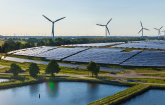Solar Photovoltaics Gaining Momentum and Poised to Challenge Fossil Fuels, Say IEEE Solar Experts
Solar PV global installed capacity expected to dramatically increase in next decade; electricity costs from solar may be more economical than traditional energy sources
PISCATAWAY, N.J., June 15, 2011 /PRNewswire/ -- Within the next 10 years, solar photovoltaic (PV) systems have the potential to be the most economical form of generating electricity, even compared to traditional fossil fuels, say solar energy experts from IEEE, the world's largest technical professional association. To achieve this cost parity, the global industry must continue to improve the efficiency of solar PV cell technologies and create economies of scale to further decrease manufacturing costs. IEEE has several initiatives to encourage these advancements.
Solar energy is the earth's most abundant energy resource. The rate of energy from sunlight hitting the earth is of the order of 100 petawatts. Just a fraction is needed to meet the power needs of the entire globe, as it takes approximately 15 terawatts to power the earth (1 petawatt = 1,000 terawatts).
"Solar PV will be a game changer," said James Prendergast, IEEE Senior Member and IEEE Executive Director. "No other alternative source has the same potential. As the cost of electricity from solar continues to decrease compared to traditional energy sources we will see tremendous market adoption, and I suspect it will be a growth limited only by supply. I fundamentally believe that solar PV will become one of the key elements of the solution to our near- and long-term energy challenges."
According to the International Energy Association (IEA), global solar PV capacity has been increasing at an average annual growth rate of more than 40 percent since 2000. By 2050, it is expected that solar PV will provide 11 percent of global electricity production, corresponding to 3,000 gigawatts of cumulative installed capacity. That would reduce greenhouse gas emissions by an estimated 2.3 gigatons, equivalent to reducing emissions from electricity use from 253 million homes per year, nearly the combined populations of Russia and Japan.
Today, however, engineering challenges remain. "For solar PV to truly compete on its own with traditional power generation, the cost and efficiency of transforming sunlight into electricity must continue to improve," said Jie Shu, IEEE member and Director of the Solar Energy Application Laboratory, Guangzhou Institute of Energy Conversion (GIEC), Chinese Academy of Sciences.
Professor Steven Ringel, IEEE Senior Member and Director of the Institute for Materials Research at The Ohio State University, confirmed that a primary remaining challenge for many PV technologies is achieving maximum efficiency as this would achieve lower system costs. "There's a really healthy competition on the technology front right now," said Ringel. "Currently, we have promising technologies that are very high efficiency but with higher cost, as well as low efficiency technologies at lower cost. The technologies that will prevail will combine the best of both, delivering the greatest efficiency at the lowest cost."
Despite the challenges, there have been significant advancements in solar PV technology and the availability of materials necessary for solar PV development. For example, the supply of silicon, a material used for solar PV, is now more available than it was just five years ago. Advancements in thin-film materials used in residential solar panels and concentrated PV used in commercial, grid-environments, solar storage, and electronic control technologies are all contributing to improvements in solar cell efficiency.
IEEE is actively working to convene a global community of experts to overcome the barriers to broader solar PV system adoption. For example, the IEEE Electron Devices Society will launch the IEEE Journal of Photovoltaics later this year. IEEE has also expanded its signature conference on solar technologies, the IEEE Photovoltaic Specialist Conference, taking place 19-24 June in Seattle, Wash., to include more than 1,000 technical presentations on solar cell research, development, manufacture, and implementation.
In fact, IEEE uses a solar PV array to generate power for the organization's headquarters in Piscataway, N.J. In 2009, a 50 kW roof-top solar array consisting of more than 275 panels was installed, reducing utility costs and lowering carbon dioxide emissions by 71.5 metric tons. This year, IEEE plans to expand the generation capacity of the existing solar array to 220 kW, with additional future phases planned for their other buildings.
Additional IEEE resources and multimedia content on solar PV include:
- IEEE.tv – "Accelerating PV" video: http://www.ieee.org/portal/ieeetv/viewer.html?progId=126007
- IEEE.tv – "Solar goes small" video: http://www.ieee.org/portal/ieeetv/viewer.html?progId=96279
- IEEE Green Your World Challenge Facebook page: www.facebook.com/ieeegreenyourworld
- IEEE Spectrum – "Putting Wireless Power To Work": http://spectrum.ieee.org/energy/renewables/putting-wireless-power-to-work
- IEEE Journal of Photovoltaics – Call For Papers: http://eds.ieee.org/jpv.html
For more information on IEEE, or to speak with a member about the benefits of solar PV, please contact: [email protected].
About IEEE
IEEE, the world's largest technical professional association, is dedicated to advancing technology for the benefit of humanity. Through its highly cited publications, conferences, technology standards, and professional and educational activities, IEEE is the trusted voice on a wide variety of areas ranging from aerospace systems, computers and telecommunications to biomedical engineering, electric power and consumer electronics. Learn more: http://www.ieee.org.
SOURCE IEEE
WANT YOUR COMPANY'S NEWS FEATURED ON PRNEWSWIRE.COM?
Newsrooms &
Influencers
Digital Media
Outlets
Journalists
Opted In






Share this article